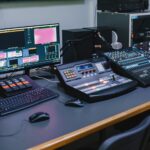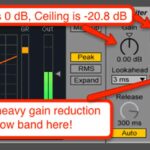The following information is meant to provide insights into a limited number of professional mics that are used for music recording and professional sound applications. This list is by no means complete, as literally hundreds of mics are available, each with its own particular design, sonic character and application.
Shure SM57
The SM57 (Figure 4.65) is widely used by engineers, artists, touring sound companies, etc., for instrumental and remote recording applications. The SM57’s midrange presence peak and good low-frequency response make it useful for use with vocals, snare drums, toms, kick drums, electric guitars and keyboards.
Figure 4.65
Shure SM57 dynamic microphone. (Courtesy of Shure Brothers, Inc., www.shure.com.) ency that often is inherent in ribbon mics. Its hypercardioid response yields a wide-frequency response/low-feedback characteristic for both studio and stage.
Transducer Type:
Ribbon Dynamic
Polar response: Hypercardioid
Frequency response: 40 to 18,000 Hz
Sensitivity: 52ÂdB (0ÂdB = 1mW/Pa)
Equivalent noise rating: −145dB
Output impedance: 200Ω.
AKG D112
Large-diaphragm cardioid dynamic mics, such as the AKG D112 (Figure 4.66), are often used for picking up kick drums, bass guitar cabinets, and other low-frequency, high-output sources.
Specifications
Transducer type: moving-coil dynamic
Polar response: cardioid
Frequency response:30 to 17,000Hz
Sensitivity: −54dB ± 3dB re. 1V/microbar.
Royer Labs R-121
The R-121 is a ribbon mic with a figure-8 pattern (Figure 4.68). Its sensitivity is roughly equal to that of a good dynamic mic, and it exhibits a warm, realistic tone and flat frequency response. Made using advanced materials and cutting-edge construction techniques, its response is flat and well balanced; the low end is deep and full without getting boomy, mids are well defined and realistic, and the high-end response is sweet and natural sounding
Specifications
Acoustic operating principle: electrodynamic pressure gradient Polar pattern: figure 8
Generating element: 2.5-micron aluminum ribbon
Frequency response: 30 to 15,000Hz ± 3dB
Sensitivity: −54dBV re. 1V/Pa ± 1dB
Output impedance: 300Ω at 1K (nominal); 200Ω optional
Maximum SPL: >135dB
Neumann KM 180 Series
The 180 Series consists of three compact miniature microphones (Figure 4.69): the KM 183 omnidirectional and KM 185 hypercardioid microphones and the successful KM 184 cardioid microphone. All 180 Series microphones are avail-able with either a matte black or nickel finish and come in a folding box with a windshield and two stand mounts that permit connection to the microphone body or the XLR-connector.
Specifications
Transducer type: condenser
Polar response: cardioid (183), cardioid (184) and hypercardioid (185)
Frequency response: 20 to 20kHz
Sensitivity: 12/15/10mV/Pa
Output impedance: 50Ω
Equivalent noise level: 16/16/18dB −A.
Telefunken M216 stereo mic
The Telefunken M216 matrix design (Figure 4.72) features a matched pair of 1-inch dual-sided capsules, a new, old-stock NOS ECC81 vacuum tube, matched custom-wound transformers, and a custom power supply with stereo matrix and Z40 encoding/decoding settings. Each channel offers nine different polar pat-terns. Cardioid, omni and figure-8 capabilities and numerous in-between pat-terns result in an extensive range of stereo imaging possibilities.
Specifications
Type: selectable pattern stereo condenser microphone
Frequency range: 20 to 20kHz
Polar pattern: cardioid, omni, figure-8 and six in-between patterns
Sensitivity: 14mV/Pa
Impedance: 200W
Signal-to-noise ratio: 125dB
Equivalent noise level: 20dB
Power requirements: Ela M916 with quadraphonic outputs.




